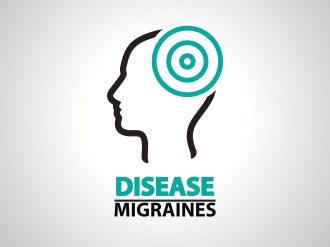Headache is the pain that occurs in the head and we feel it over the eyes or from the ears, the back of the head or the upper neck.
 Headaches according to their origin can be divided into two categories:
Headaches according to their origin can be divided into two categories:
- Primary, not related to any disease.
- Secondary associated with a disease.
The most common primary headaches include various forms of migraine, cumulative headache and tension headache.
Migraine
Migraine is a type of primary headache in which the pain is located on only one side of the head with duration of 2 - 72 hours. It usually takes the form of pulses, with severe to moderate intensity and worsening with daily activity.
It is usually accompanied by at least one of the following symptoms:
- Motion sickness
- Puke
- Inconvenience to light or sound.
The factors that can usually cause migraine include mental stress, intense physical fatigue, menstruation, insomnia, intense lights and smells, weather change, specific foods, alcoholic beverages and smoking.
Migraine is one of the most common types of headache, occurs in all ages and is more common in women. In some cases there is a hereditary disposition. The diagnosis is made after a thorough history and complete clinical examination, and in some cases further laboratory tests may be required.
Cluster Headache
Cluster headache is one of the most painful headaches. The characteristic of cluster headache is that it is excited over certain periods of time (for example, for some weeks) and from that fact (that is, it accumulates in time) it gets its name.
Cluster headache occurs more often in men and may occur at any age, but usually between 20 and 30 years of age.
 Pain in cumulative headache is located on one side of the head, usually behind the eye and the temple. The pain is accompanied by tears and redness in the eye that hurts as well as plug or run of the nostril from the pain side. When this period passes, the headaches disappear. During the period when cluster headache is active, seizures typically occur with a frequency of one to three or four per day.
Pain in cumulative headache is located on one side of the head, usually behind the eye and the temple. The pain is accompanied by tears and redness in the eye that hurts as well as plug or run of the nostril from the pain side. When this period passes, the headaches disappear. During the period when cluster headache is active, seizures typically occur with a frequency of one to three or four per day.
The duration of cluster headache attacks in most patients ranges from 30 minutes to 3 hours. It is also characteristic that many times the crisis occurs exactly at the same time of 24 hours.
Cluster headache, unlike migraine and tension headache, has no triggering factors (such as food or stress). During the crisis, however, alcohol consumption and the use of some drugs can trigger the crisis. The diagnosis is made after detailed and complete clinical examination, and in some cases further laboratory tests, may be required.
Tension Headache
Tension headache is the most common type of headache and is characterized by pain of mild or moderate intensity, usually on both sides of the head, with a pressing or clamping effect, and is unaffected by physical activity.
Pain is usually stronger in the temple or forehead area, and often people who suffer from this type of headache liken it with a vise that tightens their head. Characteristic is that there are no symptoms of nausea and vomiting and the duration of the headache may be from 30 minutes to days;
Many factors such as mental stress, sleep deprivation, depression and anxiety, analgesic abuse, and dysfunction of temporomandibular joint, play an important role in the development of this type of headache.
Sometimes, this type of headache also occurs in people who rarely develop other intense headaches of the type of migraine. In this case, headache is called mixed because it includes both forms, which are separate diseases. There is also the possibility that migraine attacks may turn into age-related crises of this type. The diagnosis is made after detailed and complete clinical examination, and in some cases further laboratory tests may be required.
All Programs of “Veresies” Clinic are approved and supervised by the Cyprus National Addictions Authority (CNAA).
CONDACT US

